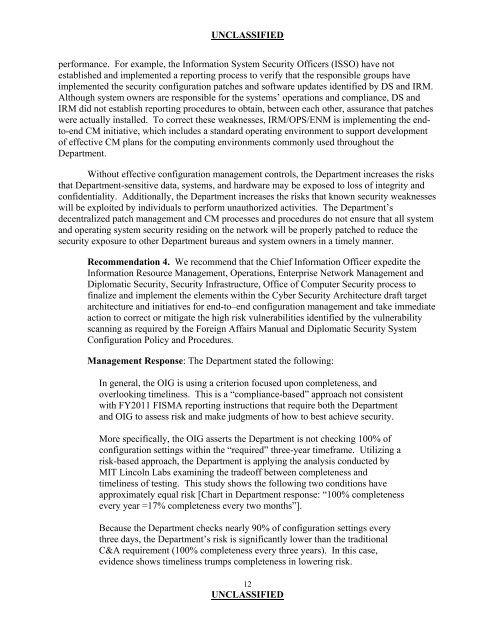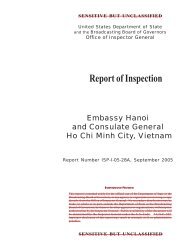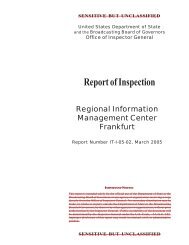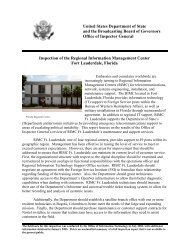Evaluation of Department of State Information Security Program ...
Evaluation of Department of State Information Security Program ...
Evaluation of Department of State Information Security Program ...
Create successful ePaper yourself
Turn your PDF publications into a flip-book with our unique Google optimized e-Paper software.
UNCLASSIFIED<br />
performance. For example, the <strong>Information</strong> System <strong>Security</strong> Officers (ISSO) have not<br />
established and implemented a reporting process to verify that the responsible groups have<br />
implemented the security configuration patches and s<strong>of</strong>tware updates identified by DS and IRM.<br />
Although system owners are responsible for the systems’ operations and compliance, DS and<br />
IRM did not establish reporting procedures to obtain, between each other, assurance that patches<br />
were actually installed. To correct these weaknesses, IRM/OPS/ENM is implementing the endto-end<br />
CM initiative, which includes a standard operating environment to support development<br />
<strong>of</strong> effective CM plans for the computing environments commonly used throughout the<br />
<strong>Department</strong>.<br />
Without effective configuration management controls, the <strong>Department</strong> increases the risks<br />
that <strong>Department</strong>-sensitive data, systems, and hardware may be exposed to loss <strong>of</strong> integrity and<br />
confidentiality. Additionally, the <strong>Department</strong> increases the risks that known security weaknesses<br />
will be exploited by individuals to perform unauthorized activities. The <strong>Department</strong>’s<br />
decentralized patch management and CM processes and procedures do not ensure that all system<br />
and operating system security residing on the network will be properly patched to reduce the<br />
security exposure to other <strong>Department</strong> bureaus and system owners in a timely manner.<br />
Recommendation 4. We recommend that the Chief <strong>Information</strong> Officer expedite the<br />
<strong>Information</strong> Resource Management, Operations, Enterprise Network Management and<br />
Diplomatic <strong>Security</strong>, <strong>Security</strong> Infrastructure, Office <strong>of</strong> Computer <strong>Security</strong> process to<br />
finalize and implement the elements within the Cyber <strong>Security</strong> Architecture draft target<br />
architecture and initiatives for end-to–end configuration management and take immediate<br />
action to correct or mitigate the high risk vulnerabilities identified by the vulnerability<br />
scanning as required by the Foreign Affairs Manual and Diplomatic <strong>Security</strong> System<br />
Configuration Policy and Procedures.<br />
Management Response: The <strong>Department</strong> stated the following:<br />
In general, the OIG is using a criterion focused upon completeness, and<br />
overlooking timeliness. This is a “compliance-based” approach not consistent<br />
with FY2011 FISMA reporting instructions that require both the <strong>Department</strong><br />
and OIG to assess risk and make judgments <strong>of</strong> how to best achieve security.<br />
More specifically, the OIG asserts the <strong>Department</strong> is not checking 100% <strong>of</strong><br />
configuration settings within the “required” three-year timeframe. Utilizing a<br />
risk-based approach, the <strong>Department</strong> is applying the analysis conducted by<br />
MIT Lincoln Labs examining the trade<strong>of</strong>f between completeness and<br />
timeliness <strong>of</strong> testing. This study shows the following two conditions have<br />
approximately equal risk [Chart in <strong>Department</strong> response: “100% completeness<br />
every year =17% completeness every two months”].<br />
Because the <strong>Department</strong> checks nearly 90% <strong>of</strong> configuration settings every<br />
three days, the <strong>Department</strong>’s risk is significantly lower than the traditional<br />
C&A requirement (100% completeness every three years). In this case,<br />
evidence shows timeliness trumps completeness in lowering risk.<br />
12<br />
UNCLASSIFIED








